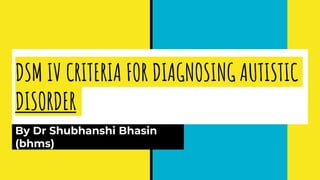Dsm iv criteria for diagnosing autistic disorder
- 1. DSM IV CRITERIA FOR DIAGNOSING AUTISTIC DISORDER By Dr Shubhanshi Bhasin (bhms)
- 2. A developmental disorder of variable severity that is characterized by difficulty in social interaction and communication and by restricted or repetitive patterns of thought and behaviour
- 3. Diagnostic and Statistical Manual (DSM)
- 4. What is the DSM-IV? The Diagnostic and Statistical Manual of Mental Disorders, Fourth EditionŌĆöDSM-IVŌĆöis the official manual of the American Psychiatric Association. Its purpose is to provide a framework for classifying disorders and defining diagnostic criteria for the disorders .
- 5. DSM-IV Criteria for Autism 3 domains of impairment: 1. Reciprocal social interaction (2 or more symptoms) 2. Language and communication (1 or more symptoms) 3. Restricted, repetitive, and stereotyped behaviors, interests, and activities (1 or more symptoms)
- 6. A.A total of 6 or more items from 1, 2 and 3. (with at least two from 1, and one each from 2 and 3)
- 7. 1. Qualitative impairment in social interaction, as manifested by at least two of the following: a. marked impairment in the use of multiple nonverbal behaviors such as eye-to-eye gaze, facial expression, body postures, and gestures to regulate social interaction. b. Failure to develop peer relationships appropriate to developmental level. c. a lack of spontaneous seeking to share enjoyment, interests or achievements with other people (e.g., by a lack of showing, bringing or pointing out objects of interest. d. lack of social or emotional reciprocity.
- 8. 2. Qualitative impairments in communication as manifested by at least one of the following: a. delay in, or total lack of, the development of spoken language (not accompanied by an attempt to compensate through alternative modes of communication such as gesture or mime). b. in individuals with adequate speech, marked impairment in the ability to initiate or sustain a conversation with others. c. stereotyped and repetitive use of language or idiosyncratic language. d. lack of varied, spontaneous, make- believe play or social imitative play appropriate to developmental level.
- 10. 3. Restricted, repetitive and stereotyped patterns of behavior, interests and activities, as manifested by at least one of the following: a. encompassing preoccupation with one or more stereotyped and restricted patterns of interest that is abnormal either in intensity or focus. b. apparently inflexible adherence to specific nonfunctional routines or rituals. c. stereotyped and repetitive motor mannerisms (e.g., hand or finger flapping or twisting, or complex whole-body movements). d. persistent preoccupation with parts of objects.
- 12. B. Delays or abnormal functioning in at least one of the following areas, with onset prior to age 3 years (1) social interaction, (2) language as used in social communication, (3) symbolic or imaginative play.
- 13. C. The disturbance is not better accounted for by Rett's Disorder or Childhood Disintegrative Disorder.
- 14. Thank you













